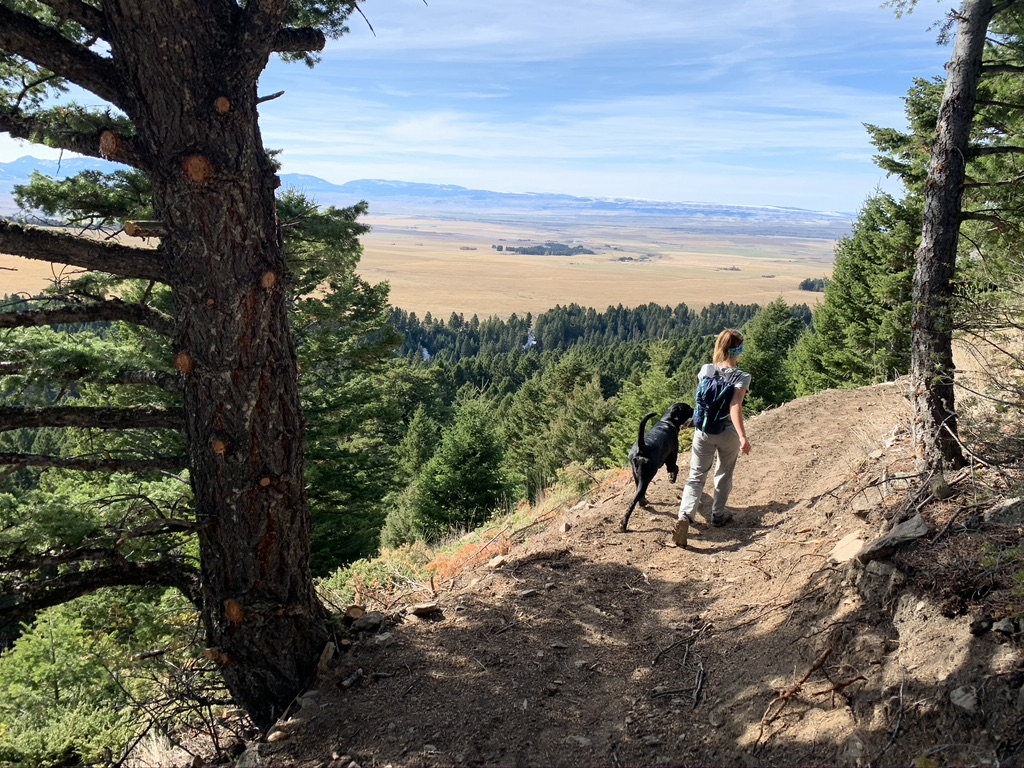Prescriptive easements on Crazy Mountain trails ‘likely non-viable’

A 2019 lawsuit brought by public land access advocates over the Forest Service’s handling of four disputed trails in the Crazy Mountains is nearing resolution, and the result could have national implications. The plaintiffs and defendants have filed their last round of major briefs and the U.S. District Court in Billings is expected to schedule an oral argument or issue a decision based on the parties’ filings in the coming months. The court’s decision is expected to set the tone for how the federal government handles future access disputes.
The plaintiffs, a consortium of sporting and conservation groups, sued the Forest Service on the grounds that the agency has failed to maintain public access on historic trails with prescriptive easements in violation of its own written policies and federal laws governing its conduct. Prescriptive easements, sometimes called historic or unperfected easements, involve right-of-way claims without an easement recorded on the deed. Prescriptive easements are common on Forest Service and Bureau of Land Management land, particularly in the West, where the expansion of railroads in the late 1800s left a legacy of checkerboard land ownership that continues to complicate land management.
In the most recent round of court filings, the government argues that even if the Forest Service once had workable claims to establish perfected easements on trails traversing private property, those claims are “likely non-viable” due to landowners blocking access. The agency’s response to landowner obstructions such as locked gates and no trespassing signs goes to the heart of the lawsuit. Plaintiffs Friends of the Crazy Mountains, the Montana chapter of Backcountry Hunters & Anglers, Skyline Sportsmen and Enhancing Montana’s Wildlife and Habitat say the Forest Service abdicated a “non-discretionary” duty outlined in its 2006 travel plan by allowing landowners to block access to the trails, three of which have been in public use for more than a century.
The Forest Service counters that it acted in accordance with federal laws including the Federal Land Policy Management Act, the National Forest Management Act, the Administrative Procedures Act and the National Environmental Policy Act. Its filings point to the paper trail involved with a rerouting of the Porcupine Lowline Trail that goes back to a 2009 environmental assessment the agency conducted to evaluate the impacts of road and trail projects on the forest. In that document, the Forest Service said it may move portions of the trail onto National Forest lands farther to the east to “correspond with final rights of way.”
In 2018, with tensions over access to the trail building, the Forest Service started moving forward with the reroute. The plaintiffs sought an injunction to prevent the Forest Service from constructing a new trail and obliterating portions of the existing trail, arguing that the reroute didn’t comply with the Custer Gallatin Forest Plan and that its environmental impacts weren’t fully vetted. Judge Susan Watters sided with the government in her July 2019 decision, finding that the plaintiffs “did not raise serious questions going to the merits” and that the public would still be free to enjoy the same areas of the forest on the rerouted trail, which opened that fall. Although the plaintiffs lost the battle over the Porcupine Lowline Trail, the broader issue of the Forest Service’s handling of access disputes is still in play.
PRESCRIPTIVE EASEMENT POLICY SHIFT
The plaintiffs say the lawsuit has revealed that the Forest Service’s approach to historic trails in the Crazies has changed markedly without the planning process or public involvement they expect to accompany such a policy shift. They say the agency has established a long record of defending prescriptive easements, as evidenced by the 2006 Custer Gallatin travel plan, the Forest Service’s defense of that plan in a lawsuit brought by landowners, and a number of policy papers, directives and communications between Forest Service employees and elected officials.
John Sullivan, board chair of the Montana chapter of Backcountry Hunters & Anglers, said he’s frustrated that there’s no apparent record of the agency working through or explaining its rationale for walking away from its long-held position that it has prescriptive easement rights on the historic trails and is duty-bound to defend them.
“Somehow with no change in law, no new court decision, no formal revision to policy, no revisions to the Travel Management Plan and no notice to the public, [the agency’s position] changed by 2021 but the only way we know this is because they responded as such to our lawsuit,” he said in an email to Montana Free Press. “The only place this change has been formally noticed is in their legal briefs. The USFS cannot be allowed to forgo its duty to defend public trails or abandon long standing public trails in this manner.”
Sullivan said the only thing he can point to that would explain the shift is “the injection of politics and politicians into the forest.” He said he suspects politically powerful landowners started leaning on elected officials in 2017 to influence the Forest Service’s administration of trails crossing private property.
Matthew Bishop, an attorney with Western Environmental Law Center who is representing the plaintiffs, said the fact that his Freedom of Information Act requests didn’t unearth an official direction change in the Forest Service’s approach to managing the disputed trails complicates the case. Had a policy change been documented, the plaintiffs could have centered that decision in their petition. Without such a record, Bishop said, his claim rests on the agency’s failure to act in accordance with its established policies and previous legal filings.
Bishop says the agency has flip-flopped from the position it has taken in other legal proceedings, including a 2007 lawsuit brought by landowners challenging the Forest Service’s decision to include disputed trails on agency maps. In that lawsuit, the Forest Service argued that “it has easement rights on the trails in question and is perfectly within its rights to reflect such rights.” Bishop said the doctrine of judicial estoppel, which aims to prevent litigants from shifting positions on legal issues to gain an advantage, is working in the plaintiffs’ favor.
“We’re basically arguing their position before versus their position now,” Bishop said.
The Department of Justice attorney representing the Forest Service in the lawsuit and Custer Gallatin Forest Supervisor Mary Erickson both said they can’t comment on active litigation, but Erickson did email MTFP what she described as “general information about Forest Service policy and how the Custer Gallatin has addressed access disputes over the years.”
“No one size fits all, thus Forest Service policy affords broad discretion to Forest officials in how to approach each access situation,” the material says. It goes on to list seven factors that can enter into consideration, including a given route’s importance relative to other access issues, the cost of pursuing or defending legal challenges, the “inherent uncertainty of a particular litigation outcome,” the existing record for each route and the costs of pursuing additional documentation, and “the desire to foster and maintain long-term respectful and cooperative relationships with neighboring landowners.”
Erickson also emailed material about the Custer Gallatin National Forest’s approach to access disputes stating that the agency has employed a mix of tools going back more than 40 years including easement purchase, easement donation, exchange, purchase of the underlying estate and reciprocal access agreements.
“Where there has been long-term disagreement over historic trails, it is common to see a variety of approaches to communication with landowners by local line officers and Forest Staff,” the material explains. “In nearly every instance, historical records often show efforts to discuss or negotiate with landowners in times of disagreement; in some instances, those conversations have moved forward to productive resolution while others have sat idle and unresolved for decades.”
WONDER RANCH, LLC v. UNITED STATES
Bishop said the agency’s current stance represents a “huge deviation” from the position it took in a lawsuit it won against Wonder Ranch over a disputed trail accessing the Lee Metcalf Wilderness, which is located in the southwestern corner of the Custer Gallatin National Forest.
In that case, U.S. District Court Judge Sam Haddon determined the Forest Service had met and maintained the criteria for a prescriptive easement through decades of use of the Indian Creek Trail. Mark Smith, the Forest Service’s attorney in the Crazy Mountains lawsuit, also represented the Forest Service in the Wonder Ranch case, which was decided in 2018 after an eight-day trial.
Sullivan said he’s hopeful Magistrate Judge Timothy Cavan will order oral arguments so the plaintiffs can have a dialogue with the court and present their concerns in a format more accessible to the public than legal briefs. (In lieu of oral arguments, Cavan could opt to decide the case based on the litigants’ existing filings.)
Bishop said there’s more at stake than the 32 miles of disputed trails referenced in the lawsuit. He points to a 2002 Forest Service briefing paper estimating there are between 200 and 250 miles of trails on the Gallatin National Forest that cross private and other non-federal land, the majority of which lack perfected easements. (The paper was issued prior to the Forest Service’s 2014 consolidation of the Custer and Gallatin national forests.)
By the plaintiffs’ estimation, thousands of miles of historic trails used by the public and managed by the Forest Service and the Bureau of Land Management could be affected nationwide if the federal government decides to discontinue its defense of prescriptive easement claims.
The lawsuit also comes in the midst of other big changes in the Crazies, including the Forest Service’s recent approval of a land swap on the south side of the range and its evaluation of another land exchange proposal involving a broad swath of land along the east side. The East Side Land Swap calls for the Forest Service to trade 4,100 acres of federal land for 5,700 acres of private land and surrender any easement claims on the East Trunk Trail, one of the trails centered in Backcountry Hunters & Anglers’ lawsuit, in exchange for the construction of a new trail that would not traverse private property.
This article was originally posted on Prescriptive easements on Crazy Mountain trails ‘likely non-viable’







